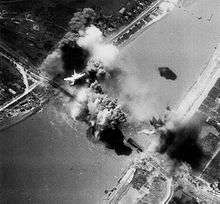Air interdiction

Air interdiction (AI), also known as deep air support (DAS), is the use of preventive aircraft attacks against enemy targets, that are not an immediate threat, in order to delay, disrupt, or hinder later enemy engagement of friendly forces. It is a core capability of virtually all military air forces, and has been conducted in conflicts since World War I.
A distinction is often made between tactical and strategic air interdiction, depending on the objectives of the operation. Typical objectives in tactical interdiction are meant to affect events rapidly and locally, for example through direct destruction of forces or supplies en route to the active battle area. While strategic objectives are often broader and more long-term, with less direct attacks on enemy fighting capabilities, instead focusing on infrastructure, logistics and other supportive assets.
The term deep air support, relates to close air support and denotes the difference between their respective objectives. Close air support, as the name suggests, is directed towards targets close to friendly ground units, as closely coordinated air-strikes, in direct support of active engagement with the enemy. Deep air support or air interdiction is carried out further from the active fighting, based more on strategic planning and less directly coordinated with ground units. Despite being more strategic than close air support, air interdiction should not be confused with strategic bombing, which is unrelated to ground operations.
Background
With air interdiction in World War I, the goal was to isolate the battlefield by strafing and bombing enemy supply lines. Favorite targets were railroad lines, bridges, and truck convoys. Due to the primitive state of aircraft and weapons technology, as well as the undeveloped nature of air doctrine and tactics, air interdiction missions in World War I were of limited utility.
The potential of air interdiction was clearly recognized, however, and during World War II it once again became a major mission of air forces. Although air interdiction operations were conducted in all theaters, the most extensive and thoroughly analyzed, particularly in the English language, were those of the United States and United Kingdom against the Axis. Specifically, the Allies launched major air interdiction efforts in the North African, Italian, and Normandy campaigns. The venues for these three campaigns were markedly different in terms of weather, terrain, the enemy’s supply and transportation infrastructure, and the availability of intelligence regarding the enemy. As a consequence of these differences, the results of air interdiction also varied. The greatest success was in the desert terrain of North Africa, where Axis forces also relied heavily on vulnerable and visible sea convoys across the Mediterranean Sea. The Italian campaign, by contrast, was characterized by mountainous terrain, poor weather conditions, and shortened German supply lines. The diverse results of these two campaigns taught air planners differing lessons.
Air interdiction has continued to play a major role in conflicts since World War II. It has been extensively used in modern conflicts such as Korea, Vietnam, Iraq, and in the 1999 NATO bombing of the Federal Republic of Yugoslavia, as well as in wars between Israel and the Arab states in the Middle East. Once again, differing local conditions and political restraints have had an enormous effect on how air interdiction was conducted and the degree to which it was successful. In Vietnam, for example, the strategic interdiction campaign known as Rolling Thunder (1965–1968) was largely unsuccessful. The dense jungle terrain, poor intelligence on enemy movements, and political restrictions on targets struck made U.S. air interdiction efforts largely futile. The flow of supplies and reinforcements from North Vietnam to their units in South Vietnam was not seriously affected. In contrast, coalition air interdiction efforts in the 1991 Gulf War were extremely successful in isolating front-line Iraqi units from their bases in the rear. Intelligence, much of it derived from space and airborne sensors, gave an unusually clear picture of enemy locations, and the open desert terrain similarly facilitated air interdiction operations.
Lessons learned
When assessing air interdiction efforts during the 20th century, it is possible to identify several factors that will affect success.
- Air superiority permits a more thorough identification and attack of enemy forces and supplies while also exposing the attacking aircraft to less risk.
- Intelligence regarding enemy dispositions, movements, stockpiles, and intentions is crucial. In the North African campaign during World War II, for example, intelligence sources gave the Allies a clear picture of Axis shipping in the Mediterranean. In contrast, in Vietnam the United States had a very poor understanding of Vietcong and North Vietnamese activities.
- Weather and terrain will have a major effect on air interdiction’s success or failure. One factor included here is the ability to conduct air interdiction at night or in marginal weather; conditions that assist the clandestine movement of forces and supplies.
- Air planners must have realistic objectives. It is virtually impossible to totally isolate the battle area. Something will always get through, and that amount may be enough to sustain the enemy.
- An enemy that is quiescent and stationary consumes few resources while also presenting few targets. If, by contrast, enemy forces are attacked and flushed from their defensive positions by friendly surface forces, they will consume far more resources, especially fuel and ammunition.
Examples of air interdiction campaigns
- Operation Strangle – attacks to disrupt Axis rail supply lines in Italy
- The attacks on Axis logistics in France (Transportation Plan) in preparation for Operation Overlord
- The attacks on the supply lines of North Korea and its allies during the Korean War
- Attacks on the Ho Chi Minh Trail which continued throughout the Vietnam War
- Operation Linebacker
- Air campaign during Operation Desert Storm
- Operation Odyssey Dawn
- Operation Inherent Resolve
See also
External links
- Air Interdiction, by Clifford Krieger. Aerospace Power Journal, Spring 1989.
- DOD dictionary definition of air interdiction.